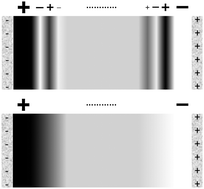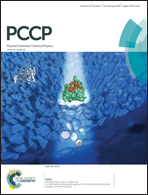Transition from non-monotonic to monotonic electrical diffuse layers: impact of confinement on ionic liquids
Abstract
Intense investigations of room temperature ionic liquids have revealed not only their advantages in a wide range of technological applications but also triggered scientific debates about charge distribution properties within the bulk and near the solid–liquid interfaces. While many observations report on an alternating charge layering (i.e., spatially extended decaying charge density oscillations), there are recent conjectures that ionic liquids bear similarity to dilute electrolytes. Using a modified Poisson–Nernst–Planck model for ionic liquids (after Bazant et al., Phys. Rev. Lett. 2011, 106, 046102), we show that both behaviors are fundamental properties of ionic liquids. The transition from the non-monotonic (oscillatory) to the monotonic structure of electrical diffuse layers appears to non-trivially depend on ionic density in the bulk, electrostatic correlation length, confinement and surface properties. Consequently, the results not only reconcile the empirical results but also provide a powerful methodology to gain insights into the nonlinear aspects of concentrated electrolytes.


 Please wait while we load your content...
Please wait while we load your content...